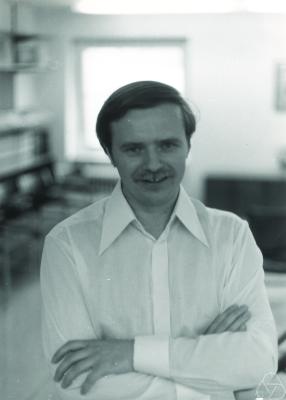
Algebraic geometry is a branch of mathematics which uses abstract algebraic techniques, mainly from commutative algebra, to solve geometrical problems. Classically, it studies zeros of multivariate polynomials; the modern approach generalizes this in a few different aspects.
In mathematics, a Noetherian ring is a ring that satisfies the ascending chain condition on left and right ideals; if the chain condition is satisfied only for left ideals or for right ideals, then the ring is said left-Noetherian or right-Noetherian respectively. That is, every increasing sequence of left ideals has a largest element; that is, there exists an n such that:

Commutative algebra, first known as ideal theory, is the branch of algebra that studies commutative rings, their ideals, and modules over such rings. Both algebraic geometry and algebraic number theory build on commutative algebra. Prominent examples of commutative rings include polynomial rings; rings of algebraic integers, including the ordinary integers ; and p-adic integers.
In algebra, ring theory is the study of rings—algebraic structures in which addition and multiplication are defined and have similar properties to those operations defined for the integers. Ring theory studies the structure of rings, their representations, or, in different language, modules, special classes of rings, as well as an array of properties that proved to be of interest both within the theory itself and for its applications, such as homological properties and polynomial identities.
In mathematics and specifically in algebraic geometry, the dimension of an algebraic variety may be defined in various equivalent ways.
Invariant theory is a branch of abstract algebra dealing with actions of groups on algebraic varieties, such as vector spaces, from the point of view of their effect on functions. Classically, the theory dealt with the question of explicit description of polynomial functions that do not change, or are invariant, under the transformations from a given linear group. For example, if we consider the action of the special linear group SLn on the space of n by n matrices by left multiplication, then the determinant is an invariant of this action because the determinant of A X equals the determinant of X, when A is in SLn.
In mathematics, a real closed field is a field F that has the same first-order properties as the field of real numbers. Some examples are the field of real numbers, the field of real algebraic numbers, and the field of hyperreal numbers.
In ring theory and homological algebra, the global dimension of a ring A denoted gl dim A, is a non-negative integer or infinity which is a homological invariant of the ring. It is defined to be the supremum of the set of projective dimensions of all A-modules. Global dimension is an important technical notion in the dimension theory of Noetherian rings. By a theorem of Jean-Pierre Serre, global dimension can be used to characterize within the class of commutative Noetherian local rings those rings which are regular. Their global dimension coincides with the Krull dimension, whose definition is module-theoretic.
In mathematics, real algebraic geometry is the sub-branch of algebraic geometry studying real algebraic sets, i.e. real-number solutions to algebraic equations with real-number coefficients, and mappings between them.
John Willard Morgan is an American mathematician known for his contributions to topology and geometry. He is a Professor Emeritus at Columbia University and a member of the Simons Center for Geometry and Physics at Stony Brook University.
In real algebraic geometry, Krivine–StenglePositivstellensatz characterizes polynomials that are positive on a semialgebraic set, which is defined by systems of inequalities of polynomials with real coefficients, or more generally, coefficients from any real closed field.
In mathematics, a basic semialgebraic set is a set defined by polynomial equalities and polynomial inequalities, and a semialgebraic set is a finite union of basic semialgebraic sets. A semialgebraic function is a function with a semialgebraic graph. Such sets and functions are mainly studied in real algebraic geometry which is the appropriate framework for algebraic geometry over the real numbers.
In mathematics, the Tarski–Seidenberg theorem states that a set in (n + 1)-dimensional space defined by polynomial equations and inequalities can be projected down onto n-dimensional space, and the resulting set is still definable in terms of polynomial identities and inequalities. The theorem—also known as the Tarski–Seidenberg projection property—is named after Alfred Tarski and Abraham Seidenberg. It implies that quantifier elimination is possible over the reals, that is that every formula constructed from polynomial equations and inequalities by logical connectives ∨ (or), ∧ (and), ¬ (not) and quantifiers ∀ (for all), ∃ (exists) is equivalent to a similar formula without quantifiers. An important consequence is the decidability of the theory of real-closed fields.

In mathematics, more specifically algebra, abstract algebra or modern algebra is the study of algebraic structures, which are sets with specific operations acting on their elements. Algebraic structures include groups, rings, fields, modules, vector spaces, lattices, and algebras over a field. The term abstract algebra was coined in the early 20th century to distinguish it from older parts of algebra, and more specifically from elementary algebra, the use of variables to represent numbers in computation and reasoning. The abstract perspective on algebra has become so fundamental to advanced mathematics that it is simply called "algebra", while the term "abstract algebra" is seldom used except in pedagogy.

Eberhard Becker is a German mathematician whose career was spent at the University of Dortmund. A very active researcher in algebra, he later became rector of the university there. During his term as rector, it was renamed the Technical University of Dortmund.
In mathematics, a positive polynomial on a particular set is a polynomial whose values are positive on that set. Precisely, Let be a polynomial in variables with real coefficients and let be a subset of the -dimensional Euclidean space . We say that:

Julius Bogdan Borcea was a Romanian Swedish mathematician. His scientific work included vertex operator algebra and zero distribution of polynomials and entire functions, via correlation inequalities and statistical mechanics.

Alexander Nikolaevich Varchenko is a Soviet and Russian mathematician working in geometry, topology, combinatorics and mathematical physics.
Bruce Reznick is an American mathematician long on the faculty at the University of Illinois at Urbana–Champaign. He is a prolific researcher noted for his contributions to number theory and the combinatorial-algebraic-analytic investigations of polynomials. In July 2019, to mark his 66th birthday, a day long symposium "Bruce Reznick 66 fest: A mensch of Combinatorial-Algebraic Mathematics" was held at the University of Bern, Switzerland.






